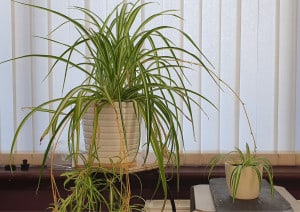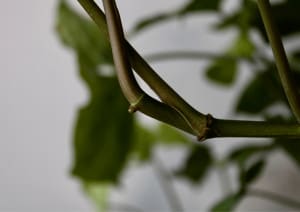What Are The Leafless Tendrils On A Boston Fern?
- Lakeisha Ethans
- April 18, 2022
If you buy something using the retail links in our articles, sometimes we earn a small affiliate commission. This does not impact the products we recommend.
Boston Ferns are great outdoor and indoor plants, providing a touch of the wild world to a domestic environment. They’re not too difficult to take care of however are not particularly beginner-friendly either and can be finicky. It’s normal to be concerned when you notice something unusual or unexpected happening on a plant like this.
One thing that you might notice growing from your Boston Fern is a long tendril-like structure that has no leaves on it. These tendrils sprout from the base of the plant and may hang down or stretch across the foliage messily. They can look a little concerning, especially if you’ve never seen them before. So what are they?
The leafless tendrils that you see on a Boston Fern are called stolons. They’re also referred to as runners or aerial roots. A stolon is a type of stem that develops to root and produce new growth. Some stolons grow horizontally, which makes them easy to confuse with root-like rhizomes. Regardless, the tendrils are natural and not a cause for concern.
The stolons of Boston Ferns are interesting to learn about, and they can tell you quite a bit about the plant itself.

What are stolons or runners on Boston Ferns?
Stolons or runners, which appear like leafless tendrils on Boston Ferns, are propagation mechanisms designed to root in the ground to produce new growth. Some plants have leaves on their runners, but Boston Ferns do not.
Stolons sprout from a plant’s base and attach themselves to soil. The stolons contain nodes that will produce roots upon burrowing underground, which starts the growth process for new greenery. The stolons will remain for a couple of years once the new plant has formed, and then they will die naturally.
In general, the existence of stolons on a Boston Fern is a good sign of a plant’s health and development. They show that your plant is doing well enough to support further growth. If the plant’s needs were not being met, it could not dedicate energy and effort to attempting new propagation, after all.
How can I promote the growth of stolons on Boston Ferns?
The more stolons you have on your plant, the more propagation can be performed! And, of course, stolons are a sign of good health. Those who wish to encourage further growth of the tendrils on a Boston Fern can do so relatively easily by taking care of their plant well.
To begin with, make sure that your Boston Fern is receiving enough sunlight – but not too much! Boston Ferns dislike excessive direct sunlight, preferring indirect full sun through a shady location. If it’s too hot or cold, the plant might need to be taken indoors.
The area of the plant should also be moist and cool. Don’t ever let them get too dry by watering them at least once per week in warmer climates. Leaves should not be allowed to dry out, no matter where the plant is placed.
This need for moisture is reflected in a Boston Fern’s soil preferences, too. Use soil that has a lot of organic matter, which allows for moisture to be maintained without clogging up the soil. Loose soil is preferred, and items like peat moss will help to promote a well-drained but moist environment. Too much water will stunt growth.
If your Boston Fern needs additional growth help, use a natural fertilizer with a slow-release quality. Fertilizer should be applied about twice each year during a point when soil is nice and moist for best absorption.
In other words, keep your Boston Fern healthy by providing it with the care and conditions that it needs and stolons will grow naturally!

How do I use stolons for Boston Fern propagation?
The best time to begin propagating your Boston Fern’s stolons is during autumn, as this is when leaves start to brown, and runners can be more easily removed. Don’t wait excessively, however, as some runners may not survive the propagation process if it’s too far into fall.
Start by turning the plant so you can see where the stolons are growing from. You will likely see some roots beginning to grow here, but it’s okay if you don’t. Remove the Boston Fern from its pot if you need more direct access. Use a sharp knife to cut off the stolons cautiously. You can also break the stolons off with your hands or fingernails. Just be cautious!
Once you have the tendrils separated from the main plant, you can choose between water propagation or immediate soil propagation. For the former, simply place them in water for a couple of days before transplanting. For the latter, just directly plant them in the soil. Don’t worry if the runners don’t have roots yet – they’ll develop them quickly once propagated!
Shoots of Boston Ferns must be planted in sterile soil that has at least one drainage hole. Plant them in shallow, small holes that are suitable for the cutting sizes. Propagating ferns can be covered with clear plastic bags to lock moisture in. This can be maintained until they show new leaf growth, upon which the bag can be removed.
Do I need to repot a Boston Fern with lots of stolons?
The leafless tendrils growing from Boston Ferns take up a lot of space, and if allowed to root, will quickly create new growth. This can cause your plant to outgrow its pot. If there are a lot of stolons growing, you should definitely consider getting a bigger pot.
This is especially true for stolons that are abundant and hanging down from the plant. These tendrils will grow from underneath the plant and start to cascade, indicating that the plant is badly in need of either pruning or repotting. You can also simply use the runners for propagation, as previously mentioned.

Is it safe to cut off stolons on Boston Ferns?
It is safe to prune the leafless tendrils on Boston Ferns. It’s rarely a bad thing to get rid of growth that you don’t want from your plant. You can remove them for aesthetic reasons or practical purposes. You should do this by pruning the tendrils from the very base of their growth for the most effectiveness.
It’s worth noting that regular overall pruning of your Boston Fern is a good way to reduce excessive stolon growth. When you prune leaves and stems, the plant diverts its attention to pushing new, healthy stem and leaf growth instead of producing additional stolons.
If you don’t want additional growth from a Boston Fern, you’ll likely have little choice but to cut off the stolons, especially when they’re present in large quantities. You can also opt to keep the runners away from soil or the ground to prevent them from taking root. Guiding the runners with ropes is an aesthetically pleasing way to direct them away from the ground.
Take home message
Leafless tendrils on a Boston Fern are completely normal and are even a sign of healthy growth. These stolons are important for the plant’s further propagation and growth and can be encouraged to develop through proper plant care. If you don’t want additional growth, you’ll need to prune the stolons off or keep them well away from any soil that they can root in.
Alternatively, stolons can be used as tools for the further propagation of more Boston Ferns. They root easily when cut off and planted. If there are a lot of stolons growing off of the plant, propagation or repotting is highly recommended if you don’t want to prune them!

Lakeisha Ethans
Houseplant Writer
Mother to two humans and hundreds of plant babies. Lakeisha uses her 15 years of experience as a content writer to specialise in simplifying what you need to know to grow and care for all indoor plants.
Similar Posts
When Do Spider Plants Have Spider Babies?
Discover when and why spider plants have spider babies and troubleshoot why your plant might not yet have produced offsets.
What Is A Spent Node? (How And When Do They Occur?)
When your plant cutting doesn't successfully propagate, is it just bad luck, or is a spent node to blame? Learn the answers in this brief post.



